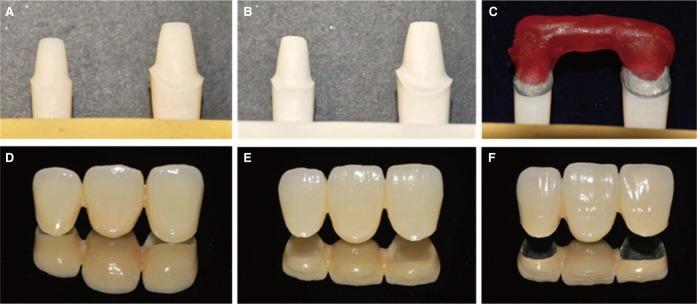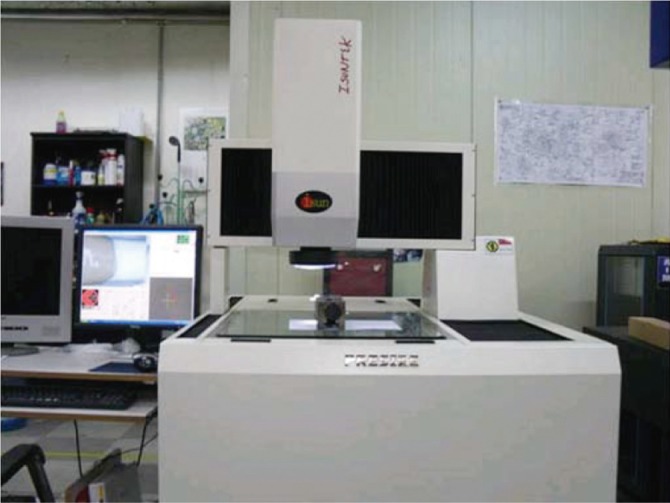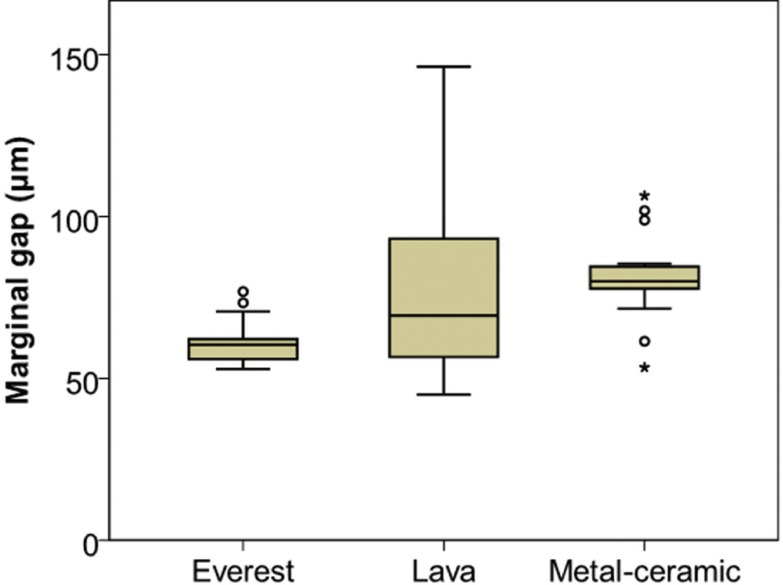J Adv Prosthodont.
2013 Aug;5(3):219-225. 10.4047/jap.2013.5.3.219.
Marginal fit of anterior 3-unit fixed partial zirconia restorations using different CAD/CAM systems
- Affiliations
-
- 1Seoul Highan Dental Clinic, Daejeon, Republic of Korea.
- 2Department of Dentistry, St. Vincent Hospital, Catholic University of Korea, Suwon, Republic of Korea.
- 3Department of Prosthodontics, School of Dentistry and Dental Research Institute, Seoul National University, Seoul, Republic of Korea. pros53@snu.ac.kr, jhoyang@snu.ac.kr
- KMID: 2118159
- DOI: http://doi.org/10.4047/jap.2013.5.3.219
Abstract
- PURPOSE
Few studies have investigated the marginal accuracy of 3-unit zirconia fixed partial dentures (FPDs) fabricated by computer-aided design/computer-aided manufacturing (CAD/CAM) system. The purpose of this study was to compare the marginal fit of zirconia FPDs made using two CAD/CAM systems with that of metal-ceramic FPDs.
MATERIALS AND METHODS
Artificial resin maxillary central and lateral incisors were prepared for 3-unit FPDs and fixed in yellow stone. This model was duplicated to epoxy resin die. On the resin die, 15 three-unit FPDs were fabricated per group (45 in total): Group A, zirconia 3-unit FPDs made with the Everest system; Group B, zirconia 3-unit FPDs made with the Lava system; and Group C, metal-ceramic 3-unit FPDs. They were cemented to resin dies with resin cement. After removal of pontic, each retainer was separated and observed under a microscope (Presize 440C). Marginal gaps of experimental groups were analyzed using one-way ANOVA and Duncan test.
RESULTS
Mean marginal gaps of 3-unit FPDs were 60.46 microm for the Everest group, 78.71 microm for the Lava group, and 81.32 microm for the metal-ceramic group. The Everest group demonstrated significantly smaller marginal gap than the Lava and the metal-ceramic groups (P<.05). The marginal gap did not significantly differ between the Lava and the metal-ceramic groups (P>.05).
CONCLUSION
The marginal gaps of anterior 3-unit zirconia FPD differed according to CAD/CAM systems, but still fell within clinically acceptable ranges compared with conventional metal-ceramic restoration.
Keyword
Figure
Cited by 1 articles
-
Comparative evaluation of marginal and internal fit of metal copings fabricated by various CAD/CAM methods
Seung-Jin Jeong, Hye-Won Cho, Ji-Hye Jung, Jeong-Mi Kim, Yu-Lee Kim
J Korean Acad Prosthodont. 2019;57(3):211-218. doi: 10.4047/jkap.2019.57.3.211.
Reference
-
1. Sorensen JA. A rationale for comparison of plaque-retaining properties of crown systems. J Prosthet Dent. 1989; 62:264–269. PMID: 2681694.
Article2. Sorensen SE, Larsen IB, Jörgensen KD. Gingival and alveolar bone reaction to marginal fit of subgingival crown margins. Scand J Dent Res. 1986; 94:109–114. PMID: 3518035.
Article3. Abbate MF, Tjan AH, Fox WM. Comparison of the marginal fit of various ceramic crown systems. J Prosthet Dent. 1989; 61:527–531. PMID: 2664137.
Article4. Yeo IS, Yang JH, Lee JB. In vitro marginal fit of three all-ceramic crown systems. J Prosthet Dent. 2003; 90:459–464. PMID: 14586310.
Article5. Gonzalo E, Suárez MJ, Serrano B, Lozano JF. A comparison of the marginal vertical discrepancies of zirconium and metal ceramic posterior fixed dental prostheses before and after cementation. J Prosthet Dent. 2009; 102:378–384. PMID: 19961996.
Article6. McLean JW, von Fraunhofer JA. The estimation of cement film thickness by an in vivo technique. Br Dent J. 1971; 131:107–111. PMID: 5283545.
Article7. Belser UC, MacEntee MI, Richter WA. Fit of three porcelain-fused-to-metal marginal designs in vivo: a scanning electron microscope study. J Prosthet Dent. 1985; 53:24–29. PMID: 3882944.
Article8. Coli P, Karlsson S. Precision of a CAD/CAM technique for the production of zirconium dioxide copings. Int J Prosthodont. 2004; 17:577–580. PMID: 15543914.
Article9. Tinschert J, Natt G, Mautsch W, Spiekermann H, Anusavice KJ. Marginal fit of alumina-and zirconia-based fixed partial dentures produced by a CAD/CAM system. Oper Dent. 2001; 26:367–374. PMID: 11504436.10. Beuer F, Naumann M, Gernet W, Sorensen JA. Precision of fit: zirconia three-unit fixed dental prostheses. Clin Oral Investig. 2009; 13:343–349.
Article11. Reich S, Wichmann M, Nkenke E, Proeschel P. Clinical fit of all-ceramic three-unit fixed partial dentures, generated with three different CAD/CAM systems. Eur J Oral Sci. 2005; 113:174–179. PMID: 15819826.
Article12. Sailer I, Fehér A, Filser F, Gauckler LJ, Lüthy H, Hämmerle CH. Five-year clinical results of zirconia frameworks for posterior fixed partial dentures. Int J Prosthodont. 2007; 20:383–388. PMID: 17695869.13. Sailer I, Fehér A, Filser F, Lüthy H, Gauckler LJ, Schärer P, Franz Hämmerle CH. Prospective clinical study of zirconia posterior fixed partial dentures: 3-year follow-up. Quintessence Int. 2006; 37:685–693. PMID: 17017630.14. Wettstein F, Sailer I, Roos M, Hämmerle CH. Clinical study of the internal gaps of zirconia and metal frameworks for fixed partial dentures. Eur J Oral Sci. 2008; 116:272–279. PMID: 18471247.
Article15. Kohorst P, Brinkmann H, Li J, Borchers L, Stiesch M. Marginal accuracy of four-unit zirconia fixed dental prostheses fabricated using different computer-aided design/computer-aided manufacturing systems. Eur J Oral Sci. 2009; 117:319–325. PMID: 19583762.
Article16. Abduo J, Lyons K, Swain M. Fit of zirconia fixed partial denture: a systematic review. J Oral Rehabil. 2010; 37:866–876. PMID: 20557435.
Article17. Okutan M, Heydecke G, Butz F, Strub JR. Fracture load and marginal fit of shrinkage-free ZrSiO4 all-ceramic crowns after chewing simulation. J Oral Rehabil. 2006; 33:827–832. PMID: 17002742.18. Gonzalo E, Suárez MJ, Serrano B, Lozano JF. Comparative analysis of two measurement methods for marginal fit in metal-ceramic and zirconia posterior FPDs. Int J Prosthodont. 2009; 22:374–377. PMID: 19639075.19. Vigolo P, Fonzi F. An in vitro evaluation of fit of zirconium-oxide-based ceramic four-unit fixed partial dentures, generated with three different CAD/CAM systems, before and after porcelain firing cycles and after glaze cycles. J Prosthodont. 2008; 17:621–626. PMID: 18798783.
Article20. Kohorst P, Brinkmann H, Dittmer MP, Borchers L, Stiesch M. Influence of the veneering process on the marginal fit of zirconia fixed dental prostheses. J Oral Rehabil. 2010; 37:283–291. PMID: 20059649.
Article21. Beuer F, Schweiger J, Edelhoff D. Digital dentistry: an overview of recent developments for CAD/CAM generated restorations. Br Dent J. 2008; 204:505–511. PMID: 18469768.
Article22. Witkowski S, Komine F, Gerds T. Marginal accuracy of titanium copings fabricated by casting and CAD/CAM techniques. J Prosthet Dent. 2006; 96:47–52. PMID: 16872930.
Article23. Bindl A, Mörmann WH. Marginal and internal fit of all-ceramic CAD/CAM crown-copings on chamfer preparations. J Oral Rehabil. 2005; 32:441–447. PMID: 15899023.
Article24. Tuntiprawon M, Wilson PR. The effect of cement thickness on the fracture strength of all-ceramic crowns. Aust Dent J. 1995; 40:17–21. PMID: 7710410.
Article25. Belles DM, Cronin RJ Jr, Duke ES. Effect of metal design and technique on the marginal characteristics of the collarless metal ceramic restoration. J Prosthet Dent. 1991; 65:611–619. PMID: 2051380.
Article26. Yoon JW, Yang JH, Han JS, Lee JB. A study on the marginal fit of collarless metal ceramic fixed partial dentures. J Korean Acad Prosthodont. 2005; 43:707–716.27. Bindl A, Mörmann WH. Fit of all-ceramic posterior fixed partial denture frameworks in vitro. Int J Periodontics Restorative Dent. 2007; 27:567–575. PMID: 18092451.28. Beuer F, Aggstaller H, Richter J, Edelhoff D, Gernet W. Influence of preparation angle on marginal and internal fit of CAD/CAM-fabricated zirconia crown copings. Quintessence Int. 2009; 40:243–250. PMID: 19417888.29. Att W, Komine F, Gerds T, Strub JR. Marginal adaptation of three different zirconium dioxide three-unit fixed dental prostheses. J Prosthet Dent. 2009; 101:239–247. PMID: 19328277.
Article30. Rosentritt M, Behr M, Kolbeck C, Handel G. Marginal integrity of CAD/CAM fixed partial dentures. Eur J Dent. 2007; 1:25–30. PMID: 19212494.31. May KB, Russell MM, Razzoog ME, Lang BR. Precision of fit: the Procera AllCeram crown. J Prosthet Dent. 1998; 80:394–404. PMID: 9791784.
Article32. Leong D, Chai J, Lautenschlager E, Gilbert J. Marginal fit of machine-milled titanium and cast titanium single crowns. Int J Prosthodont. 1994; 7:440–447. PMID: 7802912.33. Sulaiman F, Chai J, Jameson LM, Wozniak WT. A comparison of the marginal fit of In-Ceram, IPS Empress, and Procera crowns. Int J Prosthodont. 1997; 10:478–484. PMID: 9495168.
- Full Text Links
- Actions
-
Cited
- CITED
-
- Close
- Share
- Similar articles
-
- Marginal fit of the digident CAD/CAM zirconia ceramic crowns
- Effect of span length on the fit of zirconia framework fabricated using CAD/CAM system
- Marginal fit of three-unit zirconia anterior fixed dental prostheses fabricated using CAD/CAM and MAD/MAM system
- Comparison of marginal fit before and after porcelain build-up of two kinds of CAD/CAM zirconia all-ceramic restorations
- Comparison of marginal and internal fit of 3-unit monolithic zirconia fixed partial dentures fabricated from solid working casts and working casts from a removable die system





